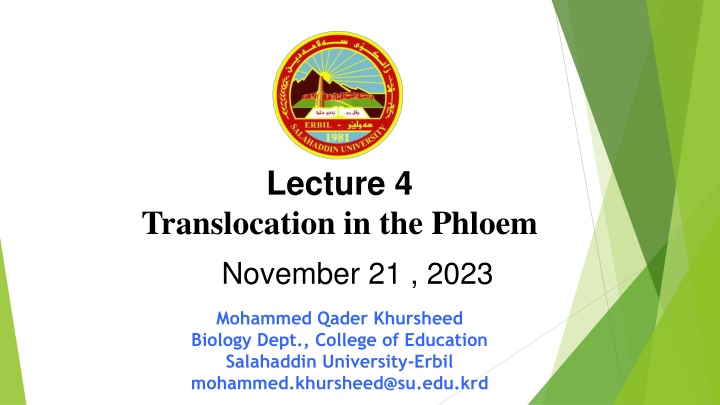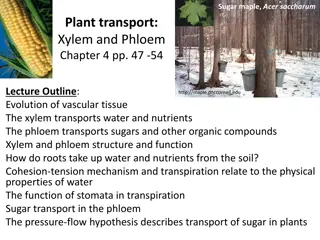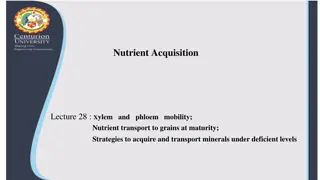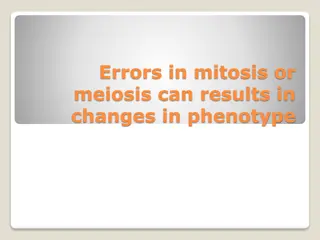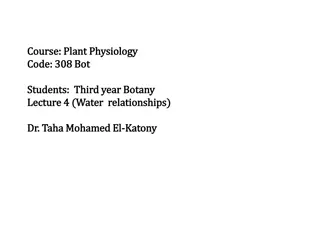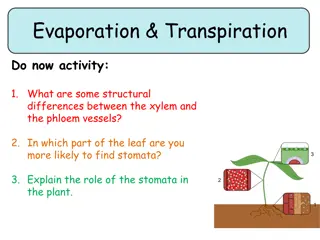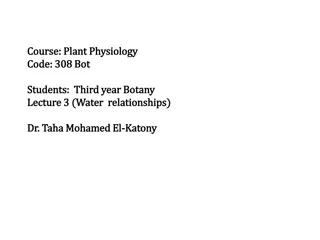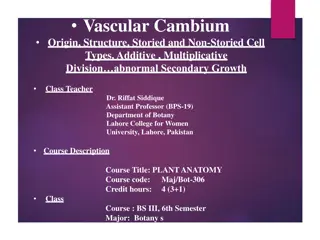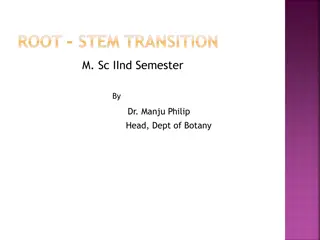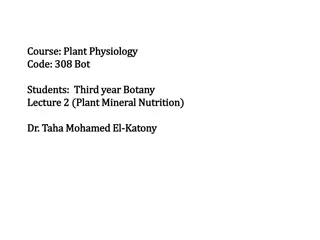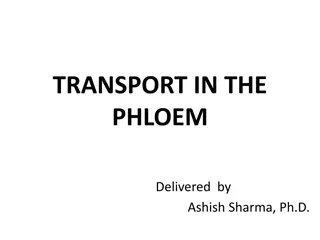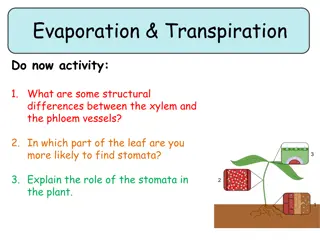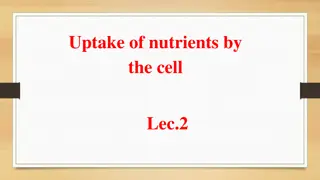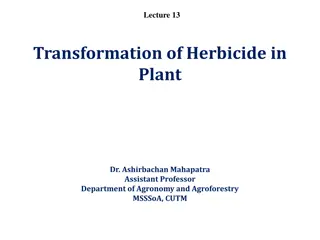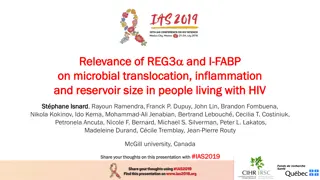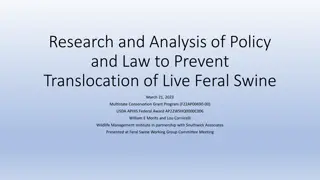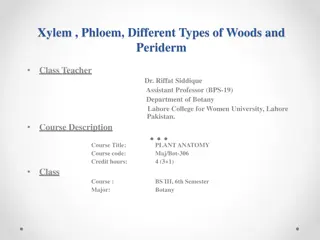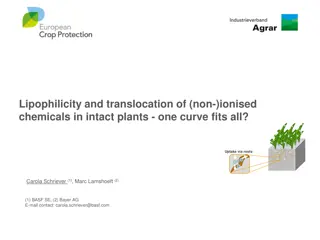Translocation in the Phloem
This lecture explores the process of translocation in the phloem, supported by evidence from studies such as aphid experiments, ringing experiments, and the use of radioactive isotopes. It delves into the materials translocated in phloem sap, including water, sucrose, non-reducing sugars, nitrogen compounds, plant hormones, and inorganic solutes. The movement of metabolites from source to sink organs is also discussed.
Download Presentation

Please find below an Image/Link to download the presentation.
The content on the website is provided AS IS for your information and personal use only. It may not be sold, licensed, or shared on other websites without obtaining consent from the author.If you encounter any issues during the download, it is possible that the publisher has removed the file from their server.
You are allowed to download the files provided on this website for personal or commercial use, subject to the condition that they are used lawfully. All files are the property of their respective owners.
The content on the website is provided AS IS for your information and personal use only. It may not be sold, licensed, or shared on other websites without obtaining consent from the author.
E N D
Presentation Transcript
Lecture 4 Translocation in the Phloem November 21 , 2023 Mohammed Qader Khursheed Biology Dept., College of Education Salahaddin University-Erbil mohammed.khursheed@su.edu.krd
Translocation studies Three lines of evidence to show that translocation takes place in the phloem 1) Aphid studies 2) Ringing experiment 3) Use of radioactive isotopes These studies also show that transport in the phloem is bi- directional Rate of phloem transport: Aphid experiments once again provide an answer...translocation rates average about 30 cm hour-1 or even faster.
Materials translocated in phloem sap Water is the most abundant substance transported in the phloem. Sucrose The sugar that is most important and abundant in translocation, sucrose is a disaccharide, i.e., made up of two sugar molecules an additional synthesis reaction is required after photosynthesis, is not a rigid structure, but mobile in itself.
Non-reducing sugars, which are translocated Sucrose, galactose, stachyose, Raffinose and verbascose. Translocated sugar alcohols include mannitol and sorbitol. Nitrogen is found in amino acids and amides, especially glutamate and aspartate and their respective amides, glutamine and asparagine. Almost all the endogenous plant hormones, including auxin, gibberellins, cytokinins, and abscisic acid.
. Nucleotide phosphates and proteins have also been found in phloem sap. Proteins found include filamentous Pproteins (which are involved in the sealing of wounded sieve elements), protein kinases (protein phosphorylation), ubiquitin (protein turnover), chaperones (protein folding), and protease inhibitors (protection of phloem proteins from degradation and defense against phloem- feeding insects). - Inorganic solutes that move in the phloem include potassium, magnesium, phosphate, and chloride. In contrast, nitrate, calcium, sulfur, and iron are relatively immobile in the phloem. .
Source to Sink Metabolites move from source to sink. SOURCE = area of supply - exporting organs: mature leaves - storage organs: seed endosperm - root of second growing season beet SINK = areas of metabolism (or storage) - non-photosynthetic organs and organs that do not produce enough photosynthetic products to support their own growth or storage - Example: roots, tubers, developing fruits/seeds, immature leaves
Sieve elements are highly specialized for translocation Longitudinal section External view
Mechanisms of translocation in phloem Mass Flow (pressure flow) Hypothesis Phloem transport is analogous to the operation of a double osmometer If solute is added to bulb A osmotic potential decreases osmotic uptake of water pressure increases bulk flow of water and solute to bulb B pressures increases in bulb water potential in B greater than in beaker osmotic flow of water into the beaker water returns to side A via the connection. This system could be maintained indefinitely if there is a mechanism to remove solute (sucrose) at the end (sink) and a mechanism to add solute (source).
At the source (leaves): Photosynthesizing cells in leaves make sucrose water potential decreases water enters cells from xylem creating high pressure potential At the sink (root): sucrose either respired or stored as starch water potential increases low pressure potential
A gradient of pressure potential exists between the source & the sink with phloem linking them and as result liquid flows from the leaves to other tissues along the sieve tube elements.
Phloem loading is the transfer of material into the phloem at the source: 1- Allow for apoplastic (from protoplast to wall to protoplast) or symplastic (from protoplasts to protoplast via plasmodesmata) transport. In some species, sucrose transport is symplastic - from mesophyll protoplast to cc-se protoplast via plasmodesmata. In others, sucrose loading into the cc-se complex involves an apoplastic step (mesophyll protoplasts to apoplast to cc-se protoplast.
Sugars are moved from photosynthetic cells and actively (energy) loaded into companion & sieve cells.
Mesophyll cell Cell walls (apoplast) Companion (transfer) cell Sieve-tube element Plasma membrane Plasmodesmata Key Apoplast Bundle- sheath cell Phloem parenchyma cell Symplast Mesophyll cell
2- The sucrose/proton cotransport system. According to this model, protons are pumped out of the sieve cells into the apoplast by a membrane-bound H+-ATPase the proton concentration increases in the apoplast pH decreases K+ is brought into the sieve cell to balance the charge the proton gradient provides the driving force for transporting sucrose against a gradient the sucrose and protons bind to a carrier protein in the membrane and are released in the sieve tube member. Evidence: the pH is high in sieve tubes; if the pH of the apoplast is increased there will be no sucrose uptake; there is a high potassium conc. in sieve tube members.
Phloem loading uses a proton/sucrose symport.
Phloem unloading is the removal of this material from the phloem in the sink. Sucrose is unloaded into the apoplast in some tissues (i.e., ovules) and into the symplast of others (growing/respiring tissues like young leaves, meristems). Apoplastic transport and unloading can occur via two methods: (a) sucrose is hydrolyzed by invertase to glucose and fructose upon reaching the sink. This maintains the gradient for transport. The glucose and fructose are taken up by the sink cells and stored or further metabolized as in maize; or (b) sucrose is unloaded into the sink by a carrier co-transport system like in sucrose loading.
P protein MW 14,000-158,000 , synthesized in companion cells, Originally thought to be a carbohydrate, called slime because it gelled when exposed to the air , Various forms; bundles of fibers or amorphous areas or even crystalline , Only in angiosperms , at least two proteins, PP1 and PP2, Once the sieve pores form, the P-protein disperses through the pore. P protein plugs the pore when the cell is damaged.
Thank You For your Listening
